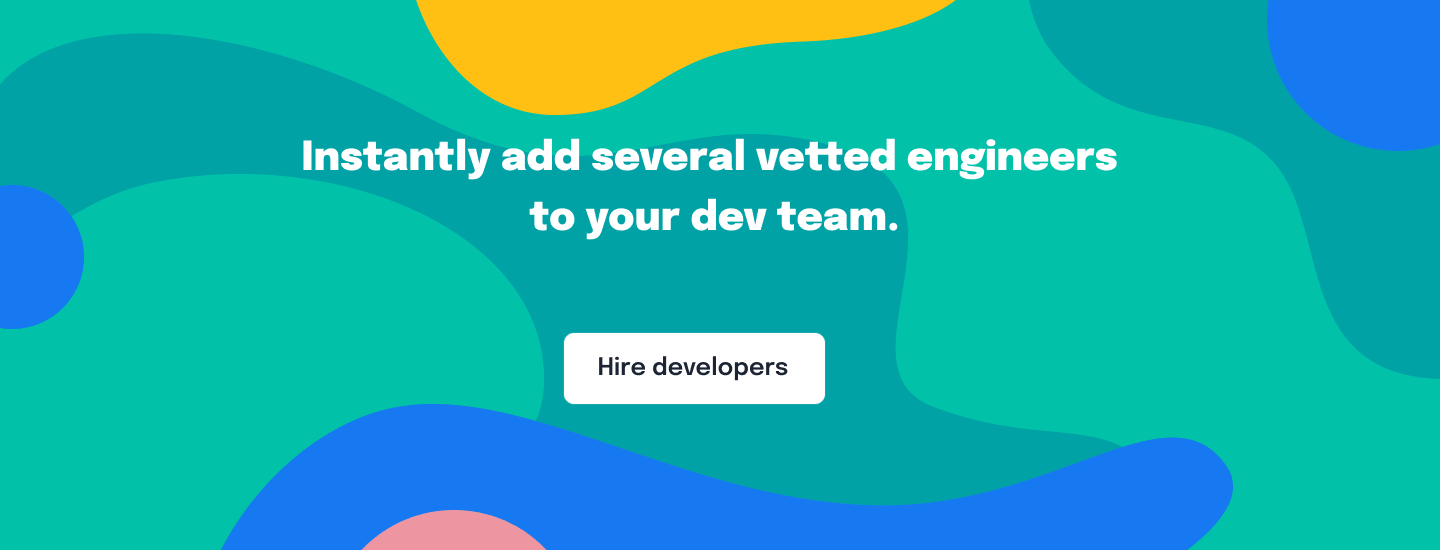Want to work with a full-stack software developer? You should not do so before you know more about the techies who call themselves full-stackers.
Slowly and steadily, every company is turning into a software company. Just like Microsoft chief Satya Nadella says, “All companies are software companies. You have to start thinking and operating like a digital company.” So no matter if you’re operating a cement company in Nebraska or a multi-cuisine restaurant in Zurich, you’d need engineers for your company, and this is what makes you a software development company.
However, describing someone as a software developer is a broad term—not one specific type of person. For example, there are front-end, back-end, and full-stack developers. In this article, we focus on the last type: full-stack software developers and what you need to know about them.
This article provides you with comprehensive information to make your decision about hiring a full-stack developer or even a dedicated team easier.
Table of Contents
Who Are Full Stack Developers?
In technical terms, a full-stack developer is a person capable of working at all layers of software development. If you’re confused with the term “layers,” bear with us for a minute. Full-stack engineers are capable of working in all three levels and hence are, therefore, in high demand. According to the Stack Overflow 2022 survey, the most popular technologies are all connected to full-stack development, which also shows the incredible growth of this developing field, thus the demand for professionals.
What Are the Main Full-Stack Layers?
Software development has three main layers. These are:
- Front-end or Presentation layer
- Back-end or Business layer
- Database layer
A front-end is part of a website/application that’s exposed to the end user. It interacts with the front-end part and consumes the service. The back-end is the part that is hidden from the users. It can live on the web browser, cache manager, and on the server. Finally, you have the database layer where everything is stored. Whenever the user requests anything, the required information is retrieved from the database. When the information is created, the essential part gets stored in the database.
The front-end comprises languages like HTML, CSS, and JavaScript. The back end has languages like PHP, Django, Node.js, and .NET. Similarly, there are different types of databases, like MongoDB, MySQL, MariaDB, and PostgreSQL.
A full-stack developer isn’t necessarily an expert in all three domains but can work, understand, and supervise the three domains. So by hiring a full-stack software developer, you’re getting an all-in-one package that can take care of your software requirements—end-to-end.
Full-Stack Developers by the Stack
Just like there are different types of software developers, there are different types of full-stack developers. To help you understand better, here are the main types of full-stack developers based on the specific tech stack:
MEAN Stack
MEAN stands for MongoDB, Express.js, Angular.js, and Node.js. All four frameworks are JavaScript-based. Together, they can create a full-fledged website/web app. Therefore, MEAN stack developers are capable of working with all four technologies.
MERN Stack
MERN stands for MongoDB, Express.js, React.js, and Node.js. React.js is another front-end library like Angular.js.
LAMP Stack
LAMP stands for Linux, Apache, MySQL, and PHP. It’s commonly used by web developers because this software stack was among the first to appear and also because it’s quite simple and reliable.
LEMP Stack
LEMP stands for Linux, NGINX, MySQL, and PHP. This stack is similar to the LAMP stack, with the only difference being the usage of Nginx instead of Apache. Thanks to this change, the server is able to autoscale when the system needs it.
Sometimes companies are looking for a full-stack developer but have one core technology of their project. In this case, the name of this technology appears in the name of the development job they open. Here are some examples of the most widely used.
Full-Stack Elixir
Elixir is a programming language suitable for both the front-end and back-end. Therefore, the list of technologies for a full-stack Elixir developer can vary. However, most often, it goes together with the framework Phoenix.
Full-Stack Python
Python comprises various libraries suitable for the front-end and back-end. Most often, Python is completed with MongoDB and MySQL for database building. Additionally, front-end development can be combined with the most typical languages and frameworks like JavaScript, React.js, Angular.js, and Bootstrap.
Full-Stack Django
Django is one of the many Python libraries and can be deployed for both front- and back-end. Python developers.
Full-Stack Java
Java-based full-stack approach to software development.
Full-Stack Ruby on Rails
Ruby on Rails is a robust web development framework suitable for both front-end and back-end tasks.
So depending on the language you’re using for development, you should hire a full-stack developer accordingly. For example, if your project requires an Angular front-end and Node.js back-end, then you’d want to employ a MEAN stack developer.
Why Do Companies Need a Full-Stack Developer?
Full-stack developers aren’t necessarily the experts in every layer. Some might be good at the front-end and modestly experienced at the back-end. So why do companies even bother hiring full-stack developers, and why are they in such demand? There are a couple of good reasons, as it turns out.
What Full-Stack Developers Can Do
Full-stack developers are in demand because of the following:
- Ability to code programs, web applications, or mobile applications.
- Coordinate the development process with other developers and team members (including product managers, project managers, and C-level executives).
- Troubleshoot technical issues at every layer.
- Outline testing techniques for various applications.
- Analyzing and debugging database queries.
- Testing codes for app validation and compatibility across required devices for quality assurance.
- Keeping a tab on important KPIs and taking initiatives as needed.
- Laying a blueprint for future requirements and communicating the same with upper management.
Therefore, full-stack developers aren’t only confined to coding work. They are responsible for a wide range of tasks that includes supervision and communication, both of which are management-related skill sets. Additionally, they’re also terrific coders on both sides of the layers. So by hiring a full-stack software developer for your firm, you’re basically hiring a top-level position that is capable of (and should be given) ownership work and providing excellent development services.
Companies also hire full-stack developers to create a minimum viable product (MVP). They develop the MVP to validate ideas and minimize the risk of a product failure during its launch. An expert full-stack developer should be equally as good at coding and UI design, making them the ideal choice for turning an idea or feature into a fully functional prototype.
What Roles Do The Developers Fit In?
Full-stack engineers usually end up donning a variety of hats when they join a company. This also depends on what role the company assigns them.
So when hiring a full-stack developer, you can assign them any of the following roles:
Tech Lead (or CTO)
They can head a technical project and oversee it end-to-end. Most experienced full-stack engineers work as tech leads. When they work as tech leads, they generally don’t do any coding but are responsible for other business-related metrics and supervising fellow developers.
Product Manager
This is a step lower in the hierarchy. Developers working as product managers offer a combination of technical and managerial skills.
Database Administrator
Since everything is stored in a database, you need someone to manage them and keep them compliant. Full-stack developers with knowledge of communication with the front and back-end are suitable for database administrator positions.
Senior Developer
Full-stack developers can chip in as pure coders and develop a software system or mobile app from scratch. Usually, they work as senior developers, courtesy of their vast working experience.
Benefits of Hiring a Full-Stack Developer
When you hire a full-stack engineer, you benefit in several ways.
Delegate Everything Technical
Firstly, you get a reliable person who is capable of taking care of everything technical. So if you have little to no software knowledge, you can delegate it to the developer and focus on what you do best. When hiring software engineers it’s important to conduct SQL test for developers, ensuring that they have the right skills and knowledge needed for the job. At the end of the day, you can be sure that the technical side of things will get done.
Make the Team Flexible
When building a software development team, you want your team to be flexible—flexible enough to adapt to changing requirements. So, you might be integrating a chatbot on your front-end and later decide to integrate smart contracts on blockchain at your back-end. Thus, your team must be equally skilled to work on both the front and back-end. A full-stack developer brings that expertise to the team.
Cost-Effectiveness
Full-stack developers typically don’t come for cheap. This is because of the skillset and expertise they possess across multiple domains. However, if you consider what it costs to hire front-end and back-end developers separately as compared to hiring one full-stack developer, you may spend less to get the job done.
Besides these, there are many more benefits that justify hiring a fulltime full-stack developer for your company.
Browse 500+ Dev Teams Available for Hire
How Much Does It Cost to Hire a Full-Stack Developer?
Proficient full-stack engineers possess almost a decade’s worth of experience working across hundreds of different projects. However, the main factor that determines the cost of hiring a full-stack developer is location. In this age of distributed teams, you can hire a developer from anywhere in the world.
Typically, developers from countries like the US, UK, Canada, Australia, and other first-world countries cost more. So, you should expect to pay around $12,000 per month.
However, full-stack developers from developing or under-developing countries often work for as little as $3,000–$5,000 per month.
Experience also matters. For example, a full-stack engineer with 10 years of experience in Ukraine might charge the same as a full-stack engineer with two years of experience in Canada.
North and South America
Developers who work and live in North America earn the highest salaries compared to others. According to Indeed, the average salary of a full-stack developer in the US is around $120,000.
However, countries of South America have much more affordable prices due to lower costs of living. For example, in Mexico, the average yearly salary of a full-stack developer is $64,000.
| Country | Junior Developer, $ | Middle Developer, $ | Senior Developer, $ |
| Mexico | $32,000 | $64,000 | $85,000 |
| Brazil | $25,000 | $54,000 | $76,000 |
| Costa Rica | $17,000 | $49,000 | $83,000 |
| Uruguay | $23,000 | $38,000 | $71,000 |
| Colombia | $17,000 | $33,000 | $58,000 |
Source: Glassdoor, Indeed, PayScale
Europe
The average salaries in European countries are also affected by the cost of living. Wages are typically higher in a Western European nation, such as Germany, compared to Eastern European countries, like Ukraine or Bulgaria.
Some Western European countries with the most expensive engineers are Germany and the UK. The average yearly salary of a full-stack developer in the UK is $68,000, according to Glassdoor, while in Germany, it is $71,000. On the other hand, the average yearly salary of a Polish engineer is $65,000, and in Bulgaria, it is $47,000.
| Country | Junior Developer, $ | Middle Developer, $ | Senior Developer, $ |
| The UK | $47,000 | $68,000 | $94,000 |
| Germany | $49,000 | $71,000 | $89,000 |
| Czech Republic | $28,000 | $67,000 | $86,000 |
| Poland | $21,000 | $65,000 | $85,000 |
| Ukraine | $18,000 | $31,000 | $52,000 |
| Hungary | $21,000 | $42,000 | $72,000 |
Source: Glassdoor, Indeed, PayScale
Africa and Asia
In general, salaries tend to be lower in countries like India and South Africa as compared to North America or Western Europe. For instance, a developer in India earns an average salary of $17,000 per year, and in South Africa, full-stack engineers earn $55,000.
| Country | Junior Developer, $ | Middle Developer, $ | Senior Developer, $ |
| India | $9,000 | $17,000 | $28,000 |
| China | $43,000 | $54,000 | $83,000 |
| Philippines | $15,000 | $22,000 | $39,000 |
| South Africa | $24,000 | $55,000 | $67,000 |
| Egypt | $7,000 | $15,000 | $33,000 |
| Kenya | $9,000 | $17,000 | $31,000 |
Source: Glassdoor, Indeed, PayScale
How To Hire Full-Stack Developers For Your Project?
Hiring a full-stack developer can be a bit different than hiring a regular software developer. You’d need to dig deep into their work experience and personality. Also, because there are many types of overlapping full-stack developers, you need to take extra measures. Bad hires cost companies thousands of dollars. So, here are a few things to check:
Skill Set and Qualification
The first and foremost thing to look for is the skill set of programmers since you’re hiring for a technical role. Here are a few things to go over:
Front-end fundamentals
Full-stack developers possess both front-end and back-end development knowledge, with a specialization in one of them. However, they should be skilled in the basics of both. So you need to check for fundamentals for front-end development. This includes topics like HTML, CSS, and JavaScript.
Server-side fundamentals
Similarly, you must test their server-side fundamental knowledge if they specialize in front-end development. This can include things like PHP, API, REST, SOAP, Cache, and AWS.
User Experience design
When designing an application, it’s essential to consider the consumer’s point of view. How will they be viewing and using the application? Therefore, a full-stack developer must have a knack for designing UX components.
Database architecture and design
Knowledge about the database is a must for any developer referring to themselves as full-stack. The developer must answer questions about how the database will be structured and deployed with complete clarity. The SQL Skill Assessment can help evaluate the developer’s ability to query data (DQL) and prepare reports.
Business Logic
Not only from the consumer point of view, but the developer must also structure the codes from the business point of view. These are those things considered necessary for the business, including data presentation and data collection.
Project Management
Since the developer will be overseeing the project from end to end, it’s better if they have project management skills or certifications. Senior developers are often certified and carry project management work experience.
Multitasking
Full-stack developers will often find themselves dealing with multiple tasks simultaneously. So you need to check how efficiently they deal with these types of tasks.
Agile Development
Other than accurate development, full-stack developers are also required to roll out applications quickly. So you need to assess their agility with different projects.
Independence
Last but not least, you need to assess if the full-stack engineer is capable of working independently or not. These developers are usually independent and like working on their own, but you have to assess this quality nevertheless.
Questions To Ask When Hiring A Full-Stack Software Developer
To check for the above factors, you’d need to devise a set of questionnaires. Obviously, this depends on your personal requirements and your expectations. However, broadly speaking, you must create full-stack development questions that look for both hard skills and soft skills.
Here are some sample questions regarding hard skills:
- What experience do you have working with this stack?
- Can you walk us through your job duties at your previous company?
- What tools do you use for testing your code?
- Are you comfortable with this specific language?
- What do you do when a code shows an error?
For testing soft skills, there’s no generalized boundary to cover. You can ask questions about how the person would solve a particular problem to something as irrelevant as a riddle. The aim here is to check for their problem-solving skills and creativity. Also, look for how well they communicate with you and other team members.
For further assistance, you can get help using YouTeam’s online interview tool with 150 questions for remote-developer interviews.
Where To Find Full-Stack Developers?
Hiring has evolved, and there are multiple ways you can hire a full-stack developer for your company. However, there’s not a single best way to hire an engineer, it depends on your requirements and preferences.
Best Countries To Hire Full-Stack Developers
There are three types of full-stack developers you can hire based on their location. Those are:
Local Hiring
Local hiring means you’re hiring within your country or state, thus, the full-stack developer is located in your vicinity. This is the most common type of hiring because of several benefits. Since the developer is located near you, you can arrange meetings, interviews, and discussions at convenient times for both parties. You can have them work from within the office or remotely. However, hiring local or in-shore talent is typically more expensive, and the number of viable candidates is more limited.
Nearshore Hiring
With this type of hiring, you’re generally looking for developers located near your country. So, for example, if your company is located in the US, nearshore talent might live in Canada or Mexico. Nearshore talent offers both talent and cost-effectiveness. Similar time zones and similarities in culture and language also are two advantages.
Offshore Hiring
Finally, you have offshore hiring where the developers are located far off in other parts of the world. For US employers, offshore talent can be in India, Ukraine, Thailand, or such locations. The main benefit of hiring offshore talent is cost reduction. Top developers from these regions charge half or one-third of what inshore talent charges. Also, you have a larger talent pool of skilled developers in these countries, which makes finding talent easier. However, you’d have to overcome issues like the language barrier, time zone disparities, and virtual meeting sessions.
Depending on what your company needs right now and what you can afford, you should outsource accordingly.
Best Platforms To Find Full-Stack Software Developers
Wellfound
This is the best place to find qualified full-stack engineers locally. It is the world’s largest startup community where developers log in regularly to find opportunities. Companies like Twitch and Stripe are hiring through Wellfound, and you can hire developers too. This is a great option to hire in-house developers.
Upwork
Upwork is the largest freelance community where you can find top-quality full-stack developers located both nearshore and offshore. Developers from all around the world can sign up and search for work. This option is good for short-term projects and non-core development tasks.
YouTeam
If you’re specifically looking for offshore developers, then YouTeam is the perfect place to find them. It has a diverse talent pool—but a stringent vetting process. You can onboard the best, vetted offshore full-stack developers in as little as one week. This option is a great choice if you’re looking for a long-term outsourcing partner for software or application development.
Why Hire Dedicated Full-Stack Developers With YouTeam?
YouTeam is a great marketplace for finding talent. The platform works only with engineers that are employed by top development agencies from Eastern Europe and Latin America. These countries provide high-quality work together with work culture and ethics similar to Western Europe and the USA, and what’s important—comfortable work time overlap.
Not every development company that wants to join YouTeam’s talent pool goes through our vetting process, just as every engineer can pass their initial screening and selection. The vetting process has different stages of the company and the developers’ check. Only the best make it through and get to list themselves in YouTeam’s talent pool. Thus, you can be sure that half of the hiring process is done for you—all of this at no hefty recruitment fees or overhead costs. You can read more about our vetting process here.
Wrap up
Hiring is never easy. There are so many things to look for, but they’re incomplete nevertheless. To find the correct full-stack developer for your project, you should look inwards at your company’s requirements because that will define the person you’re after. Then select the stack you want your application to be based on. Answering these fundamentals will lead you to the appropriate candidate. YouTeam does the rest of the job, and you can get a top developer onboarded in less than a week.







